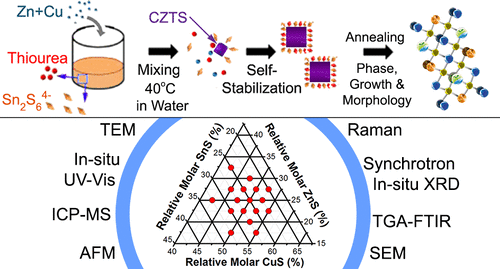Our official English website, www.x-mol.net, welcomes your
feedback! (Note: you will need to create a separate account there.)
Aqueous Synthesis of High-Quality Cu2ZnSnS4 Nanocrystals and Their Thermal Annealing Characteristics
Langmuir ( IF 3.7 ) Pub Date : 2018-01-19 00:00:00 , DOI: 10.1021/acs.langmuir.7b03885 Cameron Ritchie 1, 2 , Anthony S. R. Chesman 3 , Mark Styles 3 , Jacek J. Jasieniak 2 , Paul Mulvaney 1
Langmuir ( IF 3.7 ) Pub Date : 2018-01-19 00:00:00 , DOI: 10.1021/acs.langmuir.7b03885 Cameron Ritchie 1, 2 , Anthony S. R. Chesman 3 , Mark Styles 3 , Jacek J. Jasieniak 2 , Paul Mulvaney 1
Affiliation

|
Copper zinc tin sulfide (CZTS) nanocrystal inks are promising candidates for the development of cheap, efficient, scalable, and nontoxic photovoltaic (PV) devices. However, optimization of the synthetic chemistry to achieve these goals remains a key challenge. Herein we describe a single-step, aqueous-based synthesis that yields high-quality CZTS nanocrystal inks while also minimizing residual organic impurities. By exploiting simultaneous redox and crystal formation reactions, square-platelet-like CZTS nanocrystals stabilized by Sn2S64– and thiourea are produced. The CZTS synthesis is optimized by using a combination of inductively coupled plasma analysis, Raman spectroscopy, Fourier transform infrared spectroscopy, and synchrotron powder X-ray diffraction to assess the versatility of the synthesis and identify suitable composition ranges for achieving phase-pure CZTS. It is found that mild heat treatment between 185 and 220 °C is most suitable for achieving this because this temperature range is sufficiently high to thermalize existing ligands and ink additives while minimizing tin loss, which is problematic at higher temperatures. The low temperatures required to process these nanocrystal inks to give CZTS thin films are readily amenable to production-scale processes.
中文翻译:

高质量Cu 2 ZnSnS 4纳米晶体的水合成及其热退火特性
铜锌硫化锡(CZTS)纳米晶体油墨是开发廉价,高效,可扩展且无毒的光伏(PV)器件的有前途的候选者。然而,优化合成化学以实现这些目标仍然是关键的挑战。在本文中,我们描述了一种单步,基于水的合成方法,该方法可产生高质量的CZTS纳米晶体油墨,同时还将残留的有机杂质减至最少。通过同时进行氧化还原和晶体形成反应,Sn 2 S 6 4–会产生硫脲。通过结合电感耦合等离子体分析,拉曼光谱,傅里叶变换红外光谱和同步加速器粉末X射线衍射对CZTS合成进行优化,以评估合成的多功能性并确定合适的组成范围以实现纯CZTS。已经发现,在185至220°C之间进行温和的热处理最适合于实现这一目标,因为该温度范围足够高,可以使现有的配体和油墨添加剂热化,同时将锡损失降至最低,而锡的损失在较高的温度下是有问题的。处理这些纳米晶体油墨以产生CZTS薄膜所需的低温易于满足生产规模的要求。
更新日期:2018-01-19
中文翻译:

高质量Cu 2 ZnSnS 4纳米晶体的水合成及其热退火特性
铜锌硫化锡(CZTS)纳米晶体油墨是开发廉价,高效,可扩展且无毒的光伏(PV)器件的有前途的候选者。然而,优化合成化学以实现这些目标仍然是关键的挑战。在本文中,我们描述了一种单步,基于水的合成方法,该方法可产生高质量的CZTS纳米晶体油墨,同时还将残留的有机杂质减至最少。通过同时进行氧化还原和晶体形成反应,Sn 2 S 6 4–会产生硫脲。通过结合电感耦合等离子体分析,拉曼光谱,傅里叶变换红外光谱和同步加速器粉末X射线衍射对CZTS合成进行优化,以评估合成的多功能性并确定合适的组成范围以实现纯CZTS。已经发现,在185至220°C之间进行温和的热处理最适合于实现这一目标,因为该温度范围足够高,可以使现有的配体和油墨添加剂热化,同时将锡损失降至最低,而锡的损失在较高的温度下是有问题的。处理这些纳米晶体油墨以产生CZTS薄膜所需的低温易于满足生产规模的要求。











































 京公网安备 11010802027423号
京公网安备 11010802027423号